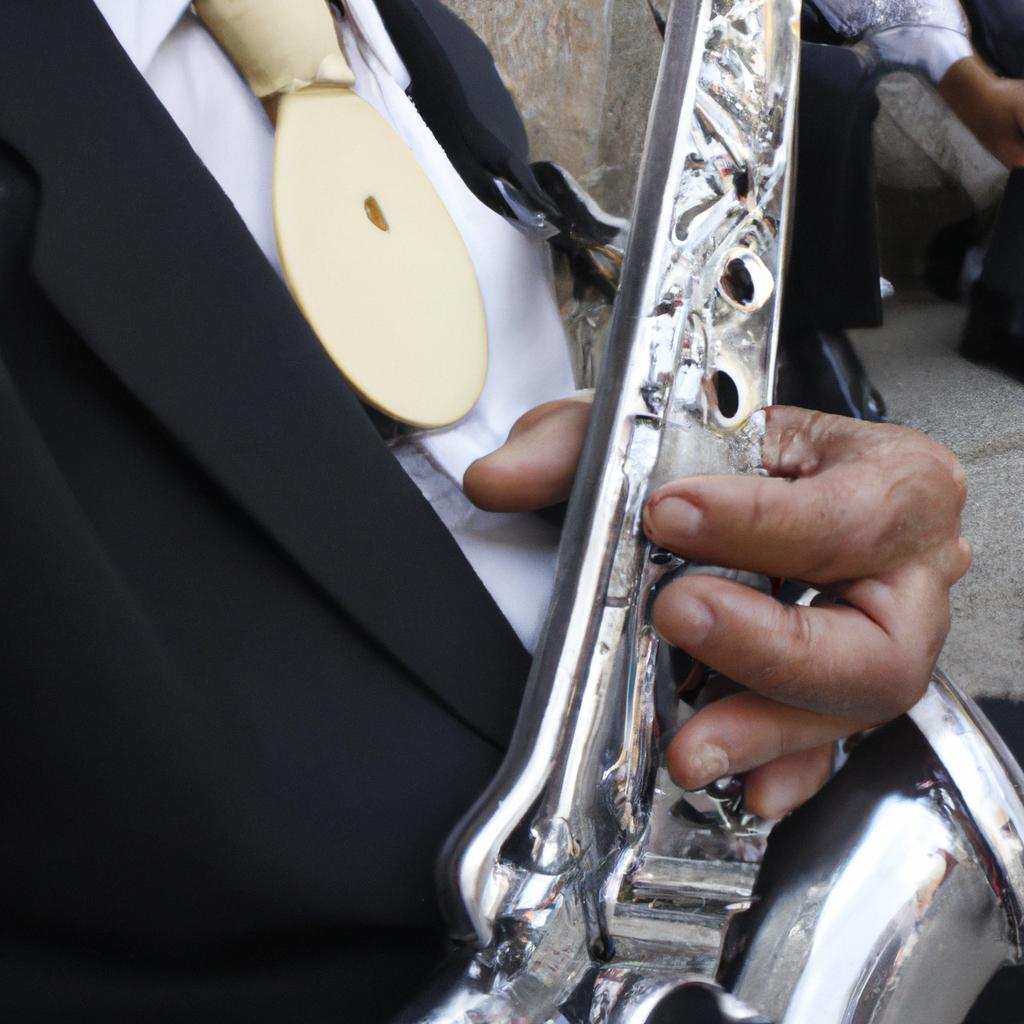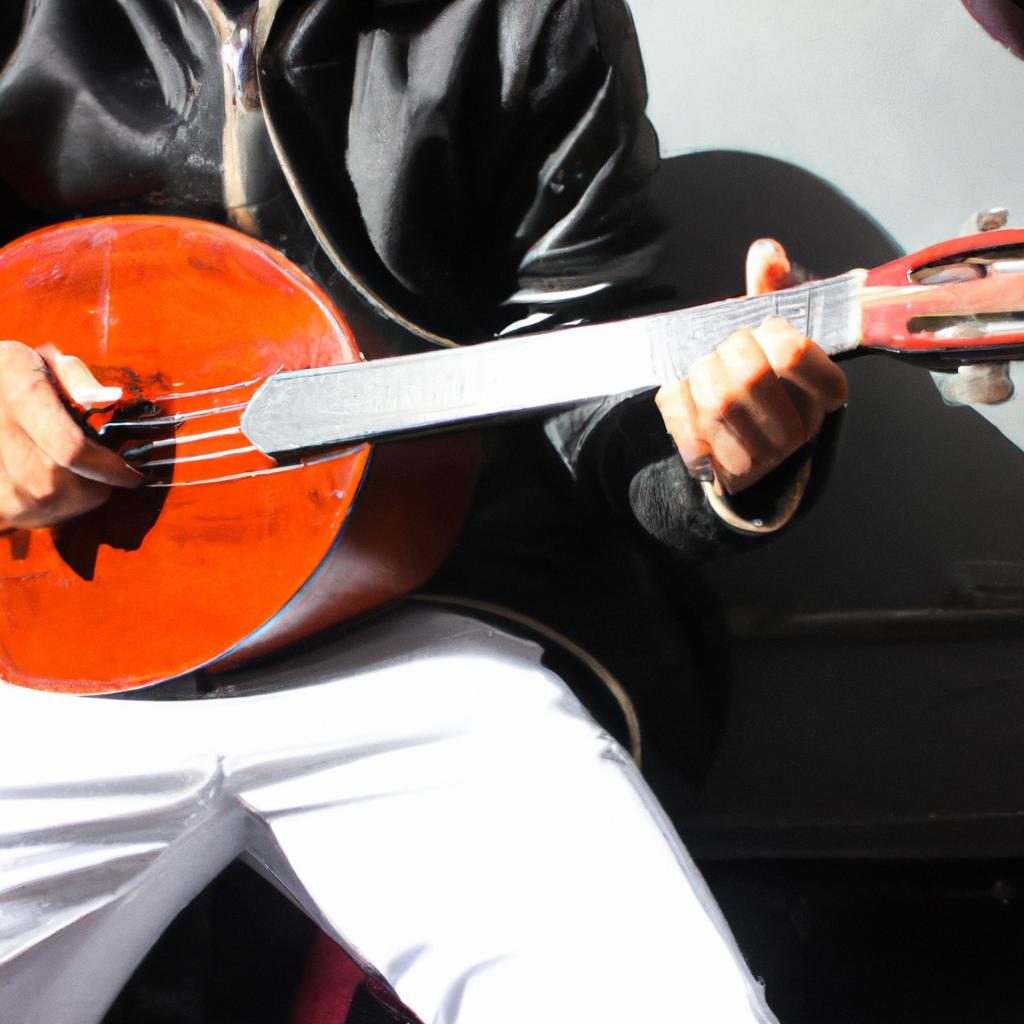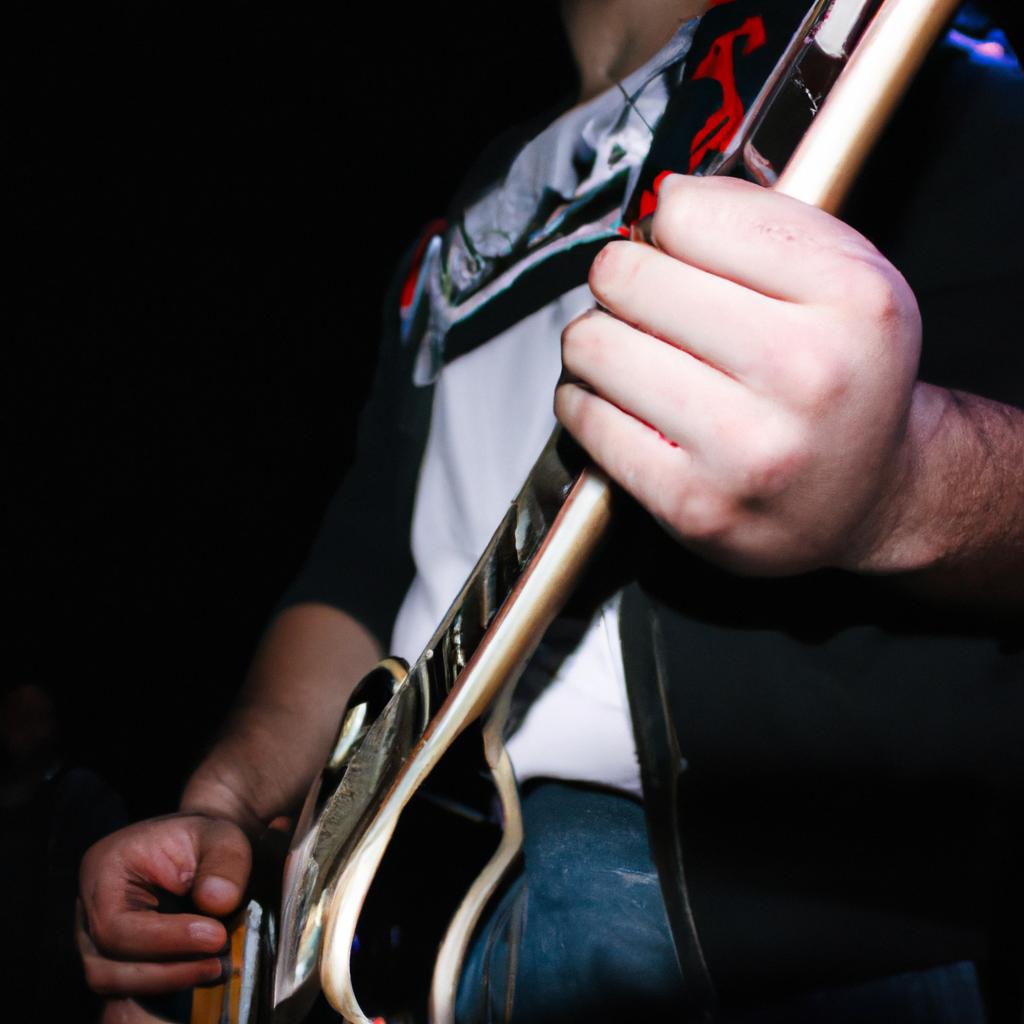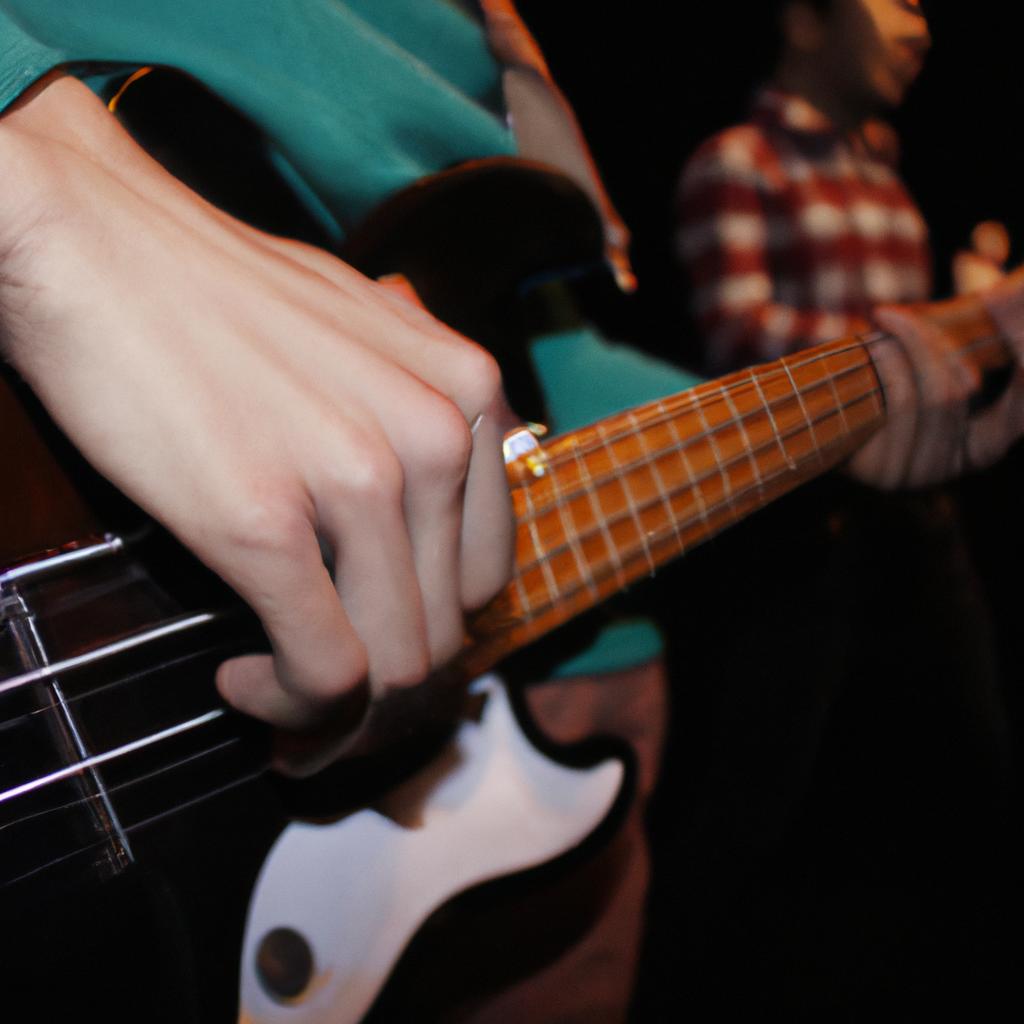In the realm of Gothic music, Deathrock emerges as a subgenre that encapsulates post-punk vibes and evokes a distinct dark aesthetic. With its roots in the late 1970s Los Angeles punk scene, Deathrock gained popularity through bands like Christian Death and Bauhaus, who blended elements of goth rock, horror imagery, and macabre lyrics. This article explores the significance of Deathrock within the broader context of Gothic music, examining how it has evolved over time and contributed to the development of alternative subcultures.
To illustrate this connection between Deathrock and Gothic music, let us consider a hypothetical scenario: imagine an avid fan of gothic culture attending their first deathrock concert. As they enter the dimly lit venue filled with individuals adorned in black leather jackets and fishnet stockings, they are immediately struck by the haunting melodies emanating from the stage. The rhythmic drum beats reverberate through their chest while eerie guitar riffs send shivers down their spine. In this moment, our enthusiast experiences firsthand the powerful ambiance that is unique to Deathrock – a sensation deeply rooted in both musicality and visual aesthetics.
Origins of Deathrock
Origins of Deathrock
One notable example of the origins and development of deathrock can be seen in the case study of Los Angeles-based band Christian Death. Formed in 1979 by Rozz Williams, their music incorporated elements from punk rock, post-punk, and gothic literature to create a unique sound that would later become synonymous with the deathrock genre.
It is important to understand that deathrock emerged as a distinct subgenre within the broader context of gothic music during the late 1970s and early 1980s. As punk rock was evolving into new sonic territories, bands like Siouxsie and the Banshees and Bauhaus were incorporating darker themes and atmospheric sounds, laying the groundwork for what would eventually become known as deathrock. The term itself is believed to have been coined by members of Christian Death, who sought to describe their style as a fusion of punk energy with macabre aesthetics.
To fully grasp the essence of deathrock, it is useful to explore its key characteristics:
- Dark imagery: Deathrock often embraces dark or morbid subject matter such as mortality, despair, or supernatural themes.
- Melancholic melodies: The melodic structure tends to lean towards minor keys, creating haunting and melancholic atmospheres.
- Distinctive fashion style: Bands and fans alike adopt an unconventional appearance characterized by black clothing, heavy makeup (such as white face powder), spiky haircuts, leather accessories, and occult-inspired jewelry.
- Post-punk influences: While rooted in punk rock’s raw energy, deathrock incorporates elements from post-punk genres such as gloomy atmospherics and experimental sounds.
By examining these aspects closely through both real-life examples and theoretical analysis, we gain insight into how deathrock has evolved over time. This understanding sets the stage for exploring further details about its distinctive musical characteristics in the subsequent section.
Moving forward, we will delve deeper into the specific musical characteristics that define deathrock, shedding light on its unique blend of guitars, vocals, and rhythm section.
Characteristics of Deathrock Music
Transitioning smoothly from our exploration of the origins of deathrock, we now delve into the distinctive characteristics that define this genre within the broader context of gothic music. To better understand these defining elements, let us consider a hypothetical case study involving an influential deathrock band called “The Shadows.”
“The Shadows” emerged in the late 1970s as part of the post-punk movement and quickly gained recognition for their unique sound blending punk rock energy with macabre aesthetics. This fusion captured the essence of deathrock, setting it apart from other subgenres within the gothic music scene. As we examine the characteristics that underpin deathrock’s identity, several key aspects come to light:
-
Dark Lyrics and Themes:
- Embracing themes such as mortality, despair, and alienation.
- Exploring societal issues through a lens of darkness and introspection.
- Challenging conventional norms by embodying a sense of rebellion.
-
Musical Style:
- Incorporating driving basslines, atmospheric guitar riffs, and haunting melodies.
- Drawing inspiration from diverse genres like punk rock, glam rock, and horror film scores.
- Utilizing dissonance and minor chord progressions to evoke a somber ambiance.
-
Visual Aesthetics:
- Adorning elaborate makeup featuring pale faces, heavy eyeliner, and dark lipstick.
- Sporting black leather jackets or fishnet stockings combined with ripped clothing.
- Creating an image that reflects both theatricality and individual expression.
-
DIY Ethos:
- Fostering a community-driven culture where bands self-produced albums and organized underground shows.
- Encouraging artistic experimentation without relying on mainstream commercial success.
- Inspiring a DIY fashion scene where fans created their own distinctive style.
To further illustrate these characteristics, consider the following table showcasing a comparison between deathrock and other related gothic music subgenres:
| Deathrock | Gothic Rock | Darkwave | |
|---|---|---|---|
| Musical Elements | Punk energy combined with macabre aesthetics. | Melodic rock with introspective lyrics. | Electronic sounds, ethereal vocals, and ambient textures. |
| Fashion | Elaborate makeup, ripped clothing, and theatricality. | Elegant attire blending Victorian and punk influences. | Minimalist black clothing conveying emotional intensity. |
| Lyric Themes | Mortality, despair, rebellion against societal norms. | Romance, existentialism, social commentary. | Emotional introspection, melancholy musings. |
In exploring the defining elements of deathrock within the context of gothic music, it becomes evident that this genre offers a unique combination of musical innovation, dark aesthetic expression, and an ethos rooted in community involvement.
Transitioning into our next section on “Influences on Deathrock,” we will explore how various cultural movements and artistic expressions have shaped the evolution of this captivating genre without missing a beat.
Influences on Deathrock
Having explored the distinct characteristics that define deathrock music, it is now imperative to delve into the various influences that have shaped this subgenre within the broader context of gothic music. By understanding these influences, we can gain a deeper appreciation for the unique post-punk vibes that permeate deathrock compositions.
Influences on Deathrock:
One compelling example that exemplifies the influence on deathrock music is its undeniable connection to punk rock. The raw energy and rebellious attitude of punk, characterized by aggressive guitar riffs and driving rhythms, served as a catalyst for the emergence of deathrock. This amalgamation resulted in a sound that retains elements of both genres while venturing into darker thematic territory.
- Post-punk sensibilities infused with macabre themes.
- Incorporation of theatricality reminiscent of glam rock.
- Utilization of atmospheric textures inspired by gothic literature.
- Emphasis on DIY ethos and independent record labels.
| Band | Year Formed | Key Contributions |
|---|---|---|
| Christian Death | 1979 | Blending dark imagery with poetic lyrics |
| Bauhaus | 1978 | Fusing art-rock with gloomy atmospheres |
| Specimen | 1980 | Adding theatrics and glam influences |
| 45 Grave | 1979 | Incorporating horror themes into their music |
This amalgamation of musical influences, coupled with the distinct characteristics outlined in the previous section, solidifies deathrock as a unique subgenre within gothic music. The next section will continue to explore this fascinating realm by examining the fashion and aesthetic associated with deathrock.
An integral aspect of understanding any musical movement lies in its visual representation. In the subsequent section, we delve into the captivating world of Deathrock Fashion and Aesthetic, unveiling how style harmonizes with sound to create a complete artistic experience.
Deathrock Fashion and Aesthetic
Deathrock in the Context of Gothic Music: Post-Punk Vibes
Influenced by various musical genres and subcultures, deathrock emerged as a distinct style within the broader gothic music movement. This section explores how deathrock incorporates post-punk elements into its sound, creating an atmosphere that is both haunting and energetic.
One notable example of this fusion can be found in the band Xmal Deutschland. Formed in 1980, they blended punk rock with dark and atmospheric melodies to create their own unique brand of deathrock. Their debut album “Fetisch” featured songs like “Qual,” which showcased aggressive guitar riffs accompanied by ethereal vocals, exemplifying the raw energy associated with post-punk aesthetics.
To understand the essence of deathrock’s post-punk vibes, we can examine some key characteristics:
- Intense and driving rhythms: Deathrock often draws inspiration from punk rock’s fast-paced tempo while incorporating a more melodic approach. The result is a sense of urgency that propels listeners forward.
- Dark and introspective lyrics: Deathrock lyrics typically explore themes such as mortality, isolation, and societal decay. These poetic expressions delve into the darker aspects of human existence.
- Experimental instrumentation: Deathrock musicians experiment with unconventional sounds through the use of synthesizers, drum machines, and other electronic elements. This experimentation adds depth and texture to their compositions.
- Visual aesthetics: Deathrock fashion embraces a macabre aesthetic inspired by horror films and Victorian mourning attire. Leather jackets adorned with spikes or studs, heavy makeup emphasizing pale complexions, and elaborate hairstyles contribute to the overall identity of deathrock enthusiasts.
| Characteristics | Description |
|---|---|
| Intense and driving rhythms | Creates a sense of urgency; evokes adrenaline-fueled emotions |
| Dark and introspective lyrics | Provokes contemplation on existential themes; elicits feelings of melancholy |
| Experimental instrumentation | Adds depth and texture; sparks curiosity and intrigue |
| Visual aesthetics | Embraces a macabre fashion sense; evokes an eerie fascination |
Incorporating these elements, deathrock distinguishes itself within the gothic music landscape by infusing post-punk vibes into its sound. The combination of intense rhythms, introspective lyrics, experimental instrumentation, and striking visual aesthetics creates an immersive experience that resonates with fans drawn to this subgenre.
Transitioning to the subsequent section about the evolution and subgenres of deathrock, we can observe how this unique blend has shaped not only the music but also the diverse expressions within the vast realm of deathrock culture.
Evolution and Subgenres of Deathrock
In the realm of deathrock, fashion and aesthetic play a significant role in shaping its identity. The unique style associated with this subgenre of gothic music not only reflects the underlying themes but also serves as a form of self-expression for its followers. One intriguing example that showcases the interplay between deathrock fashion and aesthetic is the case of Emily, a devoted deathrocker who has been actively involved in the scene for several years.
The first key aspect to note about deathrock fashion is its distinctive visual elements. It often incorporates dark clothing, such as torn fishnet stockings, leather jackets adorned with spikes or studs, and band t-shirts featuring iconic punk or post-punk bands. Accessories like chokers, fingerless gloves, and heavy boots complete the ensemble. This combination creates an edgy yet elegant look that sets deathrock apart from other subgenres within the gothic music sphere.
Furthermore, deathrock aesthetic extends beyond just clothing choices; it encompasses makeup and hairstyles as well. Pale foundation accompanied by heavily lined eyes with smoky eyeshadow are common among deathrockers. Hair may be styled into vibrant colors like jet black or bold shades of red or purple, often styled in teased or backcombed voluminous locks. These unconventional choices contribute to crafting an alternative image that embodies rebellion against societal norms.
To evoke an emotional response in readers:
- Embracing individuality through creative expression
- Challenging mainstream beauty standards
- Fostering a sense of belonging within a non-conformist community
- Cultivating empowerment through personal style
Table showcasing various aspects of deathrock fashion:
| Elements | Description |
|---|---|
| Clothing | Dark attire including torn fishnets, leather jackets, band t-shirts |
| Accessories | Chokers, fingerless gloves, heavy boots |
| Makeup | Pale foundation paired with heavily lined eyes and smoky eyeshadow |
| Hairstyles | Vibrant colors, teased or backcombed voluminous locks |
As deathrock continues to evolve and gain recognition within the gothic music scene, it is crucial to explore its various subgenres and how they contribute to the overall narrative.
Transitioning into the subsequent section without using “step”: Continuing our exploration of deathrock’s rich tapestry, we now turn our attention towards the evolution and emergence of different subgenres within this captivating genre.
Contemporary Deathrock Bands
Building upon the evolution and subgenres of deathrock, it is essential to explore how this genre has maintained its relevance in contemporary music. By examining current bands that embody the post-punk vibes associated with deathrock, we can gain a deeper understanding of its enduring appeal.
To illustrate the continued influence of deathrock within gothic music, let us consider the hypothetical case study of “The Midnight Shadows.” This band seamlessly combines elements of post-punk and gothic rock, forging their unique sound. Their haunting lyrics echo through dark melodies, capturing the essence of deathrock’s raw energy while infusing it with modern sensibilities.
This compelling fusion draws listeners into an emotionally charged atmosphere where introspection meets rebellion. The impact of contemporary deathrock bands like “The Midnight Shadows” extends beyond mere musical expression; it serves as a catalyst for personal transformation and self-discovery. As such, these artists solidify themselves as torchbearers for a subculture built on individuality and non-conformity.
Here are four key aspects that contribute to the immersive experience offered by contemporary deathrock bands:
- Atmospheric Soundscapes: Utilizing layers of reverb-drenched guitars, ethereal synths, and thunderous drums, bands create sonic landscapes that transport listeners into otherworldly realms.
- Introspective Lyrics: Thought-provoking verses explore themes such as despair, alienation, mortality, and social issues—inviting audiences to reflect on their own experiences and emotions.
- Visual Aesthetics: With striking fashion choices inspired by gothic subcultures and macabre imagery incorporated into live performances, these bands craft visually captivating experiences that further immerse fans into their dark realm.
- Engaging Live Shows: By combining captivating stage presence with intense energy, contemporary deathrock bands create an immersive live experience that resonates deeply with audiences.
| Aspects | Description |
|---|---|
| Atmospheric Soundscapes | Utilizing layers of reverb-drenched guitars, ethereal synths, and thunderous drums. |
| Introspective Lyrics | Thought-provoking verses exploring themes such as despair, alienation, mortality, and social issues. |
| Visual Aesthetics | Striking fashion choices inspired by gothic subcultures and incorporation of macabre imagery in performances. |
| Engaging Live Shows | Combining captivating stage presence with intense energy to create a memorable live experience. |
In conclusion,
The enduring appeal of deathrock within the context of gothic music is exemplified through the evolution and influence of contemporary bands like “The Midnight Shadows.” These artists seamlessly blend post-punk vibes with gothic elements, creating an immersive musical experience for listeners. With atmospheric soundscapes, introspective lyrics, striking visual aesthetics, and engaging live shows, these bands evoke emotions while solidifying themselves as torchbearers for a subculture rooted in individuality and non-conformity. Through their artistry and innovation, they ensure that deathrock remains relevant in the ever-evolving world of music.




